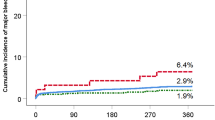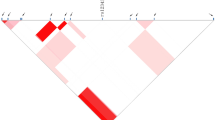Abstract
Genes involved in inflammatory processes are candidates for predisposition to prothrombotic syndromes. The variable number of tandem repeat (VNTR) polymorphism in the P-selectin glycoprotein ligand (PSGL)-1 gene has been associated with ischemic cerebrovascular disease but not with coronary heart disease (CHD). We assessed the effect of the VNTR polymorphism on CHD in two independent case/control studies. In the first study 281 CHD patients and 397 healthy blood donors were genotyped for the VNTR alleles in PSGL-1. The prevalence of homozygous carriers of the PSGL-1 VNTR allele with 15 repeat units was significantly higher in the CHD patients (5.3% vs. 1.5%) than in controls, suggesting an effect of this marker in CHD. To validate the findings genotyping was performed in a second study including 2,578 CHD patients, 731 patients without CHD, and 1084 healthy blood donors. The larger case control study had a power of 99.9% to detect the initially observed difference but failed to confirm the putative role of PSGL-1 VNTR polymorphism in CHD. Frequencies of the PSGL-1 VNTR 15 repeats for homozygous carriers were 2.2% in healthy blood donors, 2.3% in patients without CHD and 2.7%, in CHD cases, respectively. These results demonstrate that the PSGL-1 VNTR polymorphism is not a genetic risk factor for CHD. Adequately powered studies are prerequisites to obtain reliable results about genotype-phenotype relationships of new candidate genes in complex diseases.

Similar content being viewed by others
Abbreviations
- CHD :
-
Coronary heart disease
- CVD :
-
Cerebrovascular disease
- LURIC :
-
Ludwigshafen Risk and Cardiovascular Health
- PSGL :
-
P-selectin glycoprotein ligand
- VNTR :
-
Variable number of tandem repeat
References
Winkelmann BR, Hager J, Kraus WE, et al (2000) Genetics of coronary heart disease: current knowledge and research principles. Am Heart J 140:S11–S26
Libby P, Ridker PM, Maseri A (2002) Inflammation and atherosclerosis. Circulation 105:1135–1143
Hollander JE, Muttreja R, Dalesandro MR, et al (1999) Risk stratification of emergency departments patients with acute coronary syndromes using p-selectin. J Am Coll Cardiol 34:95–105
Ikeda H, Takajo Y, Ichiki K, et al (1995) Increased soluble form of P-selectin in patients with unstable angina. Circulation 92:1693–1696
Atalar E, Haznedaroglu Y, Aytemir K, et al (2000) Circulating adhesion molecules in patients with stable coronary artery disease. Int J Hematol 72:507–511
Ishiwata S, Tukada T, Nakanishi S, et al (1997) Postangioplasty restenosis: platelet activation and the coagulation-fibrinolysis system as possible factors in the pathogenesis of restenosis. Am Heart J 133:387–392
Ridker PM, Buring JE, Rifai N (2001) Soluble P-selectin and the risk of future cardiovascular events. Circulation 103:491–495
Afshar-Kharghan V, Diz-Kucükkaya R, Ludwig EH, et al (2001) Human polymorphism of P-selectin glycoprotein ligand-1 (PSGL-1) attributable to variable number of tandem decameric repeats in the mucin like region. Blood 97:3306–3307
Lozano ML, Gonzales-Conejero R, Corral J, et al (2001) Polymorphisms of P-selectin glycoprotein ligand-1 are associated with neutrophil-platelet adhesion and with ischaemic cerebrovascular disease. Br J Haematol 115:969–976
Michelson AD, Barnard MR, Krueger LA, et al (2001) Circulating monocyte-platelet aggregates are a more sensitive marker for in vivo platelet activation then platelet surface P-selectin. Circulation 104:1533–1537
Winkelmann BR, März W, Boehm BO, et al (2001) Rationale and design of the LURIC study-a resource for functional genomics, pharmacogenomics and long-term prognosis of cardiovascular disease. Pharmacogenomics 2 [Suppl 1]:S1–S73
Clayton D, Hills M (1993) Poisson and logistic regression. In: Clayton D, Hills M (eds) Statistical models in epidemiology. Oxford University Press, Oxford, pp 227–236
Siegel S, Castellan NJ (1988) Nonparametric statistics for the behavioral sciences. McGraw Hill, New York
Colhoun HM, McKeigue PM, Smith GD (2003) Problems of reporting genetic associations with complex outcomes. Lancet 361:865–872
Fleiss JL, Tytun A, Ury HK (1980) A simple approximation for calculating sample sizes for comparing independent groups. Biometrics 36:343–346
Ioannidis PPA, Trikalinos TA, Ntzani EE, Contopoulos-Ioannidis DG (2003) Genetic associations in large versus small studies: an empirical assessment. Lancet 361:567–571
Acknowledgements
This work was supported by the research program MIGROVAS of the Faculty of Clinical Medicine Mannheim, University of Heidelberg, Germany. We wish to thank Sonja Mattler for expert technical assistance. We also thank the many members of the LURIC study team either temporarily or permanently involved in patient recruitment, sample, and data handling, and all members of the laboratory team involved with genotyping the LURIC samples at the University Hospital Freiburg, Germany.
Author information
Authors and Affiliations
Corresponding author
Additional information
P. Bugert, M.M. Hoffmann, and B.R. Winkelmann, contributed equally to this work
Rights and permissions
About this article
Cite this article
Bugert, P., Hoffmann, M.M., Winkelmann, B.R. et al. The variable number of tandem repeat polymorphism in the P-selectin glycoprotein ligand-1 gene is not associated with coronary heart disease. J Mol Med 81, 495–501 (2003). https://doi.org/10.1007/s00109-003-0459-2
Received:
Accepted:
Published:
Issue Date:
DOI: https://doi.org/10.1007/s00109-003-0459-2




